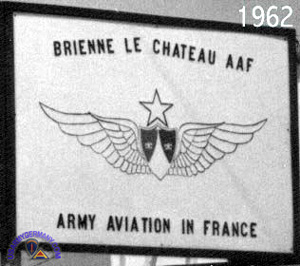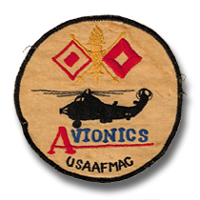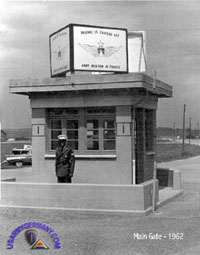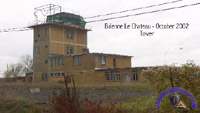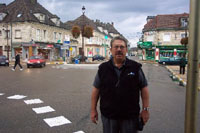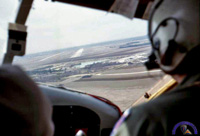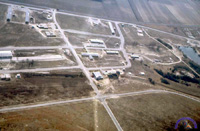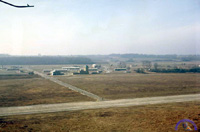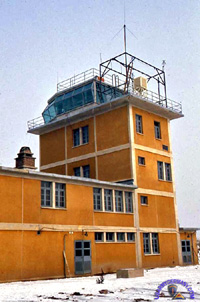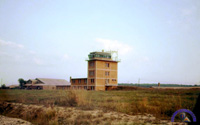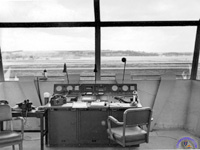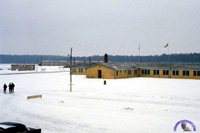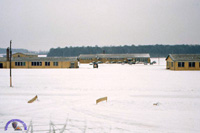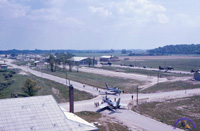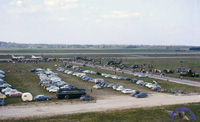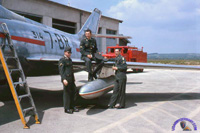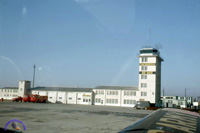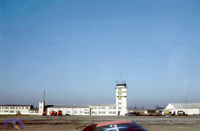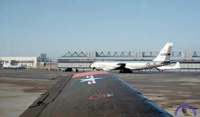| If you do
NOT see the Table of Contents frame to the left of this page, then
Click here to open 'USArmyGermany' frameset |
||||
|
Army Aviation in the European Theater |
||||
|
|
||||
|
||||
|
|
||||
| Army Aircraft Supply Center, Sandhofen, Germany | ||||
| 1955 | ||||
| (Source: STARS & STRIPES, May 1, 1955) | ||||
| The USAREUR transportation army aircraft service center, located on a former Luftwaffe airfield at Sandhofen, north of Mannheim, serves as the "backbone" of Army aviation in Europe. It's a daily occurrence to see in the center's shops and hangars (some still being completed) the uncrating and assembling of helicopters and light planes shipped disassembled from the US. These aircraft are sent to serve in air sections of medical, artillery and other units throughout Europe. Lt Col Austin J. McDermott, Jr., CO of the unit which runs the center, the 41st Transportation Battalion (Army Aircraft Maintenance) supervises a complement of 400 officers, enlisted and civilian specialists who perform the unit's dual mission: aircraft heavy maintenance and acting as base depot for issuance of aircraft. Most of his officers are pilots. The enlisted specialists are trained af the Army's Transportation Aircraft School at Ft. Sill, Okla., and the civilians are engineers. To the center from points all over Europe come fixed wing planes for overhaul and repair. Helicopters requiring higher-level maintenance than can be handled by subordinate transportation companies at Neubrucke, Baumholder or Stuttgart, are sent to the Coleman Barracks, center for heavy maintenance on the machines. Playing important roles in the service center's vital mission are the 45th Transportation Company (AAM), whose fixed-wing and rotary-wing (light plane and helicopter to groundlings) divisions do repair and assembly of four types of light planes and one type helicopter; and the 560th Transportation Company (Base Depot) which requisitions aviation supplies and issues them to maintenance outfit. (Webmaster note: the STATION LIST for May 1954 showed the three units mentioned in this article - 41st Battalion, and 45th & 560th Companies - stationed in Metz, France in 1954. They must have been moved to Sandhofen late 1954 or early 1955. Also, both the 45th and the 560th do not show up in the August 1955 STATION LIST, so (1) the 41st TC Battalion must have undergone a major reorganization in the first part of calendar 1955, or (2) the two companies were redesignated, or (3) both actions took place.) |
||||
| 1956 | ||||
| (Source: STARS & STRIPES, Jan 23, 1956) | ||||
| CO of the Army Aircraft Supply Center is Lt Col Austin J. McDermott. | ||||
| 1961 | ||||
| (Source: STARS & STRIPES, June 30, 1961) | ||||
| The Army Aircraft Supply Center at Sandhofen was established on July 1, 1955. Until 1959, the US Air Force was responsible for providing depot-level supply and maintenance support to Army aircraft throughout Europe. In Oct 1959, the depot-level responsiblity was transferred to the Army, with that responsibility then falling under the Chief of Transportation, (HQ USAREUR). Since 1955, the transportation depot at Sandhofen has grown from a small direct support maintenance unit to an organization capable of supporting all Army aircraft this side of the Atlantic. |
||||
| Army Aviation Maintenance Center, Sandhofen, Germany | ||||
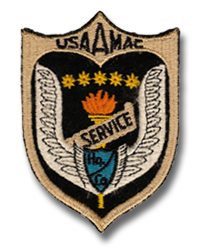 US Army Aviation Maintenance Center patch US Army Aviation Maintenance Center patch |
||||
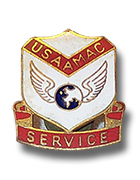 USAAMAC crest USAAMAC crest |
||||
| 1963 | ||||
| (Source: STARS & STRIPES, May 22 1963) | ||||
| The US Army Aviation Maintenance Center at Sandhofen provides depot-level maintenance and repair of all types of Army Aviation aircraft for units in Germany, France, Italy and MAAG's in Greece, Turkey, Iran, Pakistan, India, Ethiopia and the Congo Republic. Established in 1955 as the Army Aircraft Supply Center, the organization started out as a direct support unit providing third-echelon maintenance and supply support to Army Aviation units in the field. Since then it has grown into an organization capable of providing support to all Army aircraft in Europe and surrounding areas. All maintenance functions are performed in the maintenance hangars at Coleman Army Airfield and at the Army Avn Maint Acty (AAMA) at Brienne-le-Chateau in France. MAINTENANCE DIVISION Some of the shops that support the Center's mission: IROAN Program - Inspect and Repair Only As Necessary The IROAN Program is a major part of the Center's activities. Two types of aircraft are currently rebuilt under this program at the Sandhofen facility: At the Brienne Activity, the U-1A (Otter) fixed wing aircraft is overhauled under the IROAN Program. Other aircraft such as the U-8 (Seminole) fixed-wing and CH-34 (Choctaw) helicopter are IROAN'ed at other Western European manufacturers contracted by the Center. SUPPLY DIVISION Another major aspect of the Center's mission is performed by the Supply Division. More than 13,000 different items (from aircraft engines to rotor blades to packets of nuts and bolts) are stored in the warehouse for issue to the Center and to contract sites. MOVEMENT CONTROL SECTION This section handles incoming and outgoing shipments of parts and equipment. |
||||
 Henry Cox, a member of the USAAMAC Honor Guard |
||||
| (Source: Henry Cox, Facebook) | ||||
| Went over to Germany in June 1963 on the USS Patch, docked in Bremerhaven, and took a train to Coleman Barracks, Mannheim. Saw lots of farms - kinda reminded me of Tennessee. Don't recall the name of the troop transport I came home on in January 1966; we docked in NY, had to wait 1 day to dock @ a certain time. Arrived at the United States Army Aviation Maintenance Center, Coleman Barracks, Sandhofen, and was assigned to Headquarters Company, USAAMAC. Had a great time during my stay in Germany. Great memories. My work station was in the Supply Warehouse, right across the ditch from the Army Stockade. I could see the Stockade from my office window. I was a transportation supply parts specialist. We supplied aircraft parts. Was in charge of finding out where lost parts were. Was on the phone a lot with different units in Europe. If I remember correctly my barracks was building number 90. We had a hole in the fence we used to sneak out & back in. I remember supply specialist Paul Lovell from Texas I believe. Bill Meeks, Aldofo Cruz, Dickinson Wright, Paul Colusmo (Weight lifter). |
||||
| 1970 | ||||
| (Source: STARS & STRIPES, Feb 24 1970) | ||||
| A recent briefing held at the US Army Aviation Maintenance Center (USAAMAC) in Sandhofen provided the following information on that operation: Col. O. B. Butler is the current commanding officer of the The Army's aircraft maintenance center which opened on Oct. 17, 1962. There are some 575 personnel assigned to the center experts that is responsible for repairing disbaled or damaged aircraft. The center will assume a new mission on June 30 - to process aircraft in and out of the European Theater while still performing its original mission of providing general aviation maintenance and repair support. The command also operates a direct exchange system for selected high cost aircraft supplies, and serves as a focal point for evacuation of all unserviceable aviation items. Coleman Army Airfield is the most active Army Airfield in Europe, operating 16 hours daily, seven days a week. The airfield handled 70,099 instrument and visual takeoffs and landings in 1969. The European theater aircraft inventory has increased three-fold in the seven years since the USAAMAC facility opened in 1962. In (fiscal year) 1969 USAAMAC repaired 120 programmed and crash-damaged aircraft and put them back on the line. |
||||
| Army Aviation Systems Support Center, Sandhofen, Germany | ||||
| 1971 | ||||
| (Source: STARS & STRIPES, May 13 1971) | ||||
| The U.S. Army Aviation Maintenance Center at Coleman Barracks, Sandhofen, has been reassigned to TASCOM's 1st Support Brigade and has been redesignated as the US Army Aviation Systems Support Center. Newly assigned to the center have been the 582nd Direct Support Co and the 56th Aviation Co, both at Coleman. Named center CO is Lt. Col. Harrell N. Gillis, succeeding Col. Olva B. Butler, assigned to VII Corps Hq, Stuttgart. |
||||
| Army Aviation Maintenance Acty, Brienne-le-Chateau, France | ||||
| (Source: Email from Jack Jakubik, Avionics Div, Aircraft FM & Avionics Cen, Eur) | ||||
Brienne Le Chateau AAF (APO 325), France |
||||
|
||||
U.S. Army Aircraft Field Maintenance and Avionics Center - Europe The Army moved into Brienne in September 1961, and remained until June 1965. The Army put it to good use, establishing the only major Army aircraft avionics modification center in Europe for their fleet of over 750 helicopters and fixed wing aircraft, as well as certain classified aircraft brought in from the Middle East and Asia. The center was dedicated to avionics rework and testing of aircraft. It upgraded communications, radar, autopilot, and reconnaissance sensors systems in their fleet. |
||||
|
||||
The Army returned Brienne to France on 24 June 1965. The airport was purchased by the Brienne Chamber of Commerce and later sold for private development. It has been an airport for sports aviation, sky diving and soaring. Two hangers and several flight line buildings have been used for an aviation museum. The hangers and several buildings still exist today. Brienne airfield was considered as the site for a super air cargo airport, but the local residents objected loudly, so the developers moved on to Chalons which is now being developed as the largest air cargo terminal in Europe. I visited Brienne Le Chateau in October 2002. The old Avionics hanger is still in use as a small museum and flight school. An Industrial Park occupies the old barracks. Most of the other buildings such as the Mess Hall, PX-Snack Bar, H.Q. Building, Officers Club, Enlisted Men’s Club and Tower (Base Operations) look as though a bomb had hit them and should be demolished. The marguerites are all grown over and the runway looks pretty shabby. But it still handles take-offs and landings. The town is all grown up and boasts a population of 3,500 inhabitants. The Chateau itself, which overlooks the town, is an imposing building of the latter half of the 18th century. A statue of Napoleon commemorates his sojourn at Brienne from 1779 to 1784, when he was studying at the Military School. The Center Bar and Hotel is still there, and has not changed a bit over the years. Le Pinchonett Bar, down on the river Aube is still standing and the proprietor is the son of the original owner. A drive through the old French countryside is like stepping back into the pages of history. |
||||
| (Source: Email from Michael von Ascheberg) | ||||
| I was stationed to Coleman Barracks (Mannheim-Sandhofen, Germany) from December 20, 1962 until February 14, 1963. In February, being originally from Paris France, I volunteered to go to Brienne where I remained until the closing of the base in June 1965. From Brienne I was sent back to Coleman Barracks and finally left for Fort Leonard Wood Missouri in November 1966. During my time in Europe I photographed quite a bit using slide film. In addition, there are three photos I took in 1963 when we flew from Brienne le Chateau to Chateauroux Air Base. |
||||
| (Army Aviation Maintenance Acty?), Nordenham, Germany | ||||
| 1964 | ||||
| (Source: STARS & STRIPES, January 4 1964) | ||||
| DEPOT LEVEL MAINTENANCE The Nordenham Helicopter Repair Station is operated by the Weser Aircraft Plant at the mouth of the Weser River in northern Germany near Bremerhaven. The facility is responsible for (depot-level) helicopter maintenance, repair and modifications under contract to the US Army. The plant handles between 12 to 20 helicopters at any given time. The plant overhauls Army helicopters after every three years or 1,000 flying hours -- which ever comes first. After a complete disassembly of the helicopter, a 100-percent inspection of each part is performed, the parts are repainted, electric wiring is carefully checked, the helicopter is reassembled and then tested completey. The facility also performs modifications on the H-34A Choctaws used by USAREUR, converting the "A" model to CH-34C's (installation of automatic stabilization and new radio equipment). Besides four Americans (Army personnel), there are 18 German inspectors and 45 German workmen employed at the plant. There are similar plants in Belgium, France, Spain and Holland. Similar work is also performed at the Army Transportation Depot at Mannheim (Sandhofen). |
||||
|
|
||||
| Related Links: |
||||

